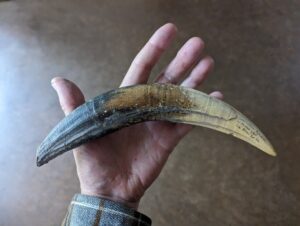|
We often assume that Creation was about the same when humans arrived in North America sometime between 21,000 and 23,000 years ago. During the last ice age (driven by the Milankovitch Cycle), when sea levels were as much as 400 feet lower than present, humans migrated from Siberia across the land mass now called Beringia – a broad land corridor connecting Asia with North America. Beringia was a shrub tundra ecosystem that provided livable habitat for the human community as it moved eastward and then south along the western North American coast. As the climate warmed and the glacial ice retreated, sea levels rose, eventually submerging Beringia – but humans were now in North America. But what did these early humans encounter? As humans moved south into warmer climates, they faced creatures that might “shiver your timbers”. The megafauna – animals that dominated Europe, Asia, and North/South America during the Pleistocene were mammal species weighing more than 100 pounds (45 kg). Can you imagine living in Washington State today with mastodon, wooly mammoth, giant short-faced bear, saber-toothed cat, dire wolf, Harlan’s ground sloth, yesterday’s camel, western horse, giant beaver, American zebra, American lion, ancient bison and many more. It was a far different world than we experience today. And it was only a few thousand years ago! There has been much written about the disappearance of the megafauna. Indeed two-thirds of Earth’s large mammal species outside of Africa disappeared at the end of the last ice age. An interesting recent publication “Science” (18 August 2023) is titled “Pre-Yunger Dryas Megafaunal Extirpation at Rancho La Brea Linked to fire-driven State Shift”. It focused on seven species of megafauna trapped in the la Brea tar pits in California. What factor(s) drove these species to extinction has been long debated. The two principal suggestions have been climate change and the overkill hypothesis driven by human hunting. Indeed, human predation has been verified by projectile points embedded in bones (see included image). Low reproductive rates characterized the megafauna. Even a small but significant increase in the death rate in species faced with climate change could have tipped the scale, resulting in eventual extinction. As the large herbivores went, so did the large carnivores. But the 18 August 2023 science paper suggests a new extinction driver, at least for the region around La Brea. 15,000 years ago, the climate was moist and cool, with a landscape dominated by juniper and oak that provided suitable habitat for the many species of local megafauna. About 13,000 years ago, as the climate warmed, the region became significantly drier. Over a period of approximately 300 years, a “state shift” in the dominant ecosystem took place. The oak-juniper woodland was replaced by chaparral, a shrubland fire-prone plant now characteristic of the region. The change in dominant vegetation is recorded in the pollen found in lake-bottom sediments. But another clue is also present – an abundance of charcoal from massive fires that spread across the landscape. Were the fires lightning caused? Or were they human-caused in the progressively drier landscape possibly to drive prey as commonly done by later native North Americans to obtain deer, elk, and bison? The role of humans remains unclear. In the much drier landscape, fire spread rapidly and played a driving role in the regional ecosystem shift. The overkill hypothesis remains possible as earth enters the sixth major extinction episode. That will be the topic of a coming Creation’s Corner. |
|
— Joe Sheldon Thanks for listening. Direct comments to [email protected] If you would like to receive additional information on Creation care, notices of special events, Creation walks I lead, etc. please contact me at the above address and I will add you to my e-mail list. |



